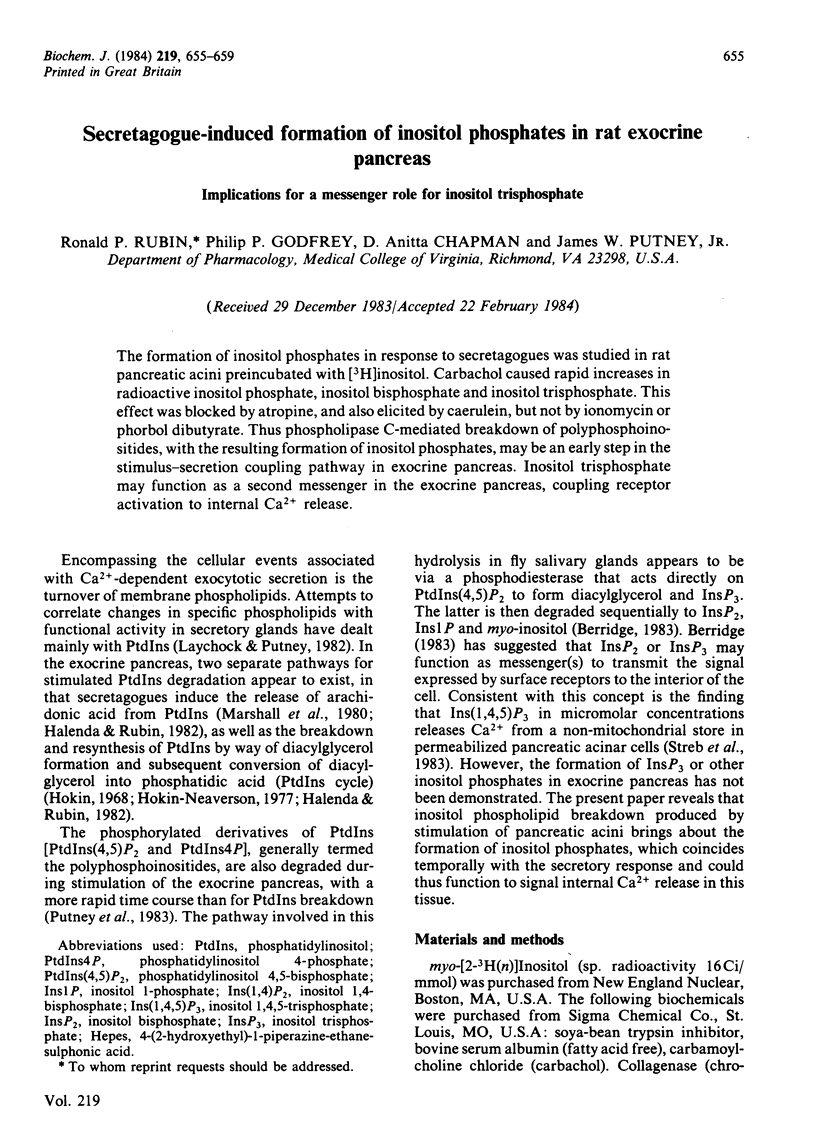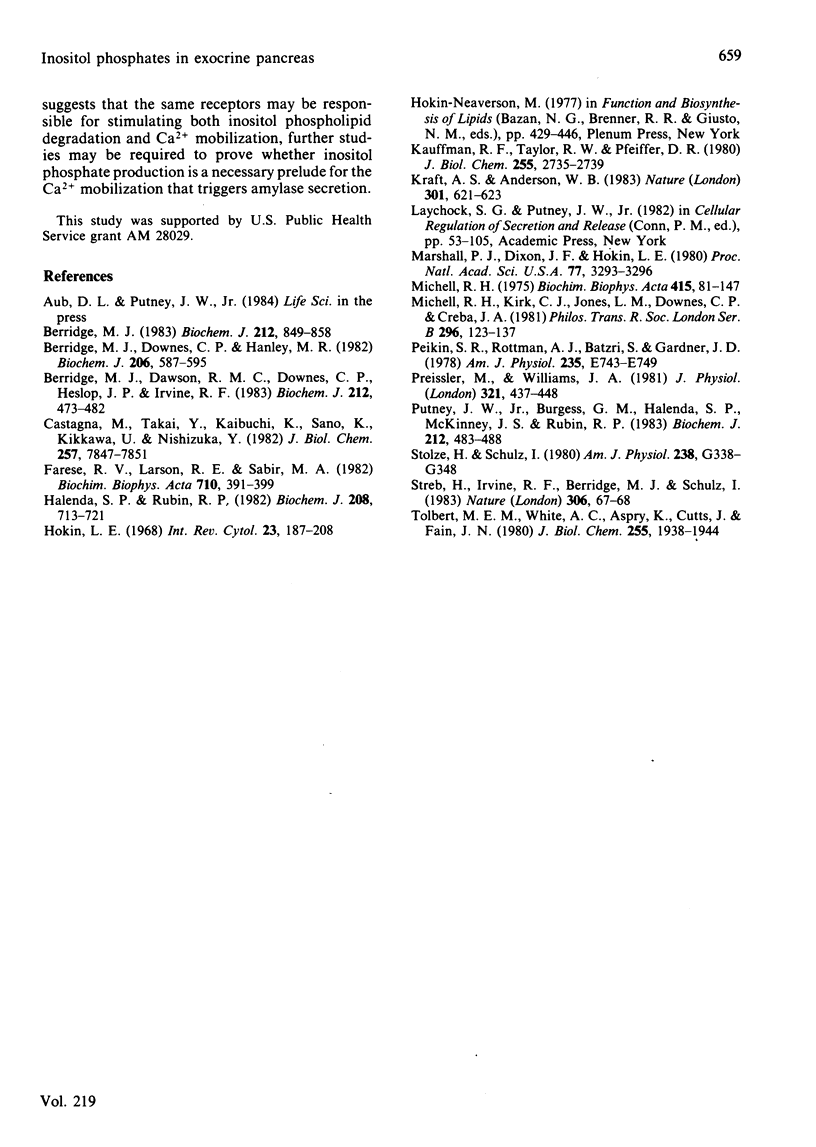Abstract
The formation of inositol phosphates in response to secretagogues was studied in rat pancreatic acini preincubated with [3H]inositol. Carbachol caused rapid increases in radioactive inositol phosphate, inositol bisphosphate and inositol trisphosphate . This effect was blocked by atropine, and also elicited by caerulein, but not by ionomycin or phorbol dibutyrate. Thus phospholipase C-mediated breakdown of polyphosphoinositides, with the resulting formation of inositol phosphates, may be an early step in the stimulus-secretion coupling pathway in exocrine pancreas. Inositol trisphosphate may function as a second messenger in the exocrine pancreas, coupling receptor activation to internal Ca2+ release.
Full text
PDF




Selected References
These references are in PubMed. This may not be the complete list of references from this article.
- Berridge M. J., Dawson R. M., Downes C. P., Heslop J. P., Irvine R. F. Changes in the levels of inositol phosphates after agonist-dependent hydrolysis of membrane phosphoinositides. Biochem J. 1983 May 15;212(2):473–482. doi: 10.1042/bj2120473. [DOI] [PMC free article] [PubMed] [Google Scholar]
- Berridge M. J., Downes C. P., Hanley M. R. Lithium amplifies agonist-dependent phosphatidylinositol responses in brain and salivary glands. Biochem J. 1982 Sep 15;206(3):587–595. doi: 10.1042/bj2060587. [DOI] [PMC free article] [PubMed] [Google Scholar]
- Berridge M. J. Rapid accumulation of inositol trisphosphate reveals that agonists hydrolyse polyphosphoinositides instead of phosphatidylinositol. Biochem J. 1983 Jun 15;212(3):849–858. doi: 10.1042/bj2120849. [DOI] [PMC free article] [PubMed] [Google Scholar]
- Castagna M., Takai Y., Kaibuchi K., Sano K., Kikkawa U., Nishizuka Y. Direct activation of calcium-activated, phospholipid-dependent protein kinase by tumor-promoting phorbol esters. J Biol Chem. 1982 Jul 10;257(13):7847–7851. [PubMed] [Google Scholar]
- Farese R. V., Larson R. E., Sabir M. A. Ca2+-dependent and Ca2+-independent effects of pancreatic secretagogues on phosphatidylinositol metabolism. Biochim Biophys Acta. 1982 Mar 12;710(3):391–399. doi: 10.1016/0005-2760(82)90122-9. [DOI] [PubMed] [Google Scholar]
- Halenda S. P., Rubin R. P. Phospholipid turnover in isolated rat pancreatic acini. Consideration of the relative roles of phospholipase A2 and phospholipase C. Biochem J. 1982 Dec 15;208(3):713–721. doi: 10.1042/bj2080713. [DOI] [PMC free article] [PubMed] [Google Scholar]
- Hokin L. E. Dynamic aspects of phospholipids during protein secretion. Int Rev Cytol. 1968;23:187–208. doi: 10.1016/s0074-7696(08)60272-7. [DOI] [PubMed] [Google Scholar]
- Kauffman R. F., Taylor R. W., Pfeiffer D. R. Cation transport and specificity of ionomycin. Comparison with ionophore A23187 in rat liver mitochondria. J Biol Chem. 1980 Apr 10;255(7):2735–2739. [PubMed] [Google Scholar]
- Kraft A. S., Anderson W. B. Phorbol esters increase the amount of Ca2+, phospholipid-dependent protein kinase associated with plasma membrane. Nature. 1983 Feb 17;301(5901):621–623. doi: 10.1038/301621a0. [DOI] [PubMed] [Google Scholar]
- Marshall P. J., Dixon J. F., Hokin L. E. Evidence for a role in stimulus--secretion coupling of prostaglandins derived from release of arachidonoyl residues as a result of phosphatidylinositol breakdown. Proc Natl Acad Sci U S A. 1980 Jun;77(6):3292–3296. doi: 10.1073/pnas.77.6.3292. [DOI] [PMC free article] [PubMed] [Google Scholar]
- Michell R. H. Inositol phospholipids and cell surface receptor function. Biochim Biophys Acta. 1975 Mar 25;415(1):81–47. doi: 10.1016/0304-4157(75)90017-9. [DOI] [PubMed] [Google Scholar]
- Peikin S. R., Rottman A. J., Batzri S., Gardner J. D. Kinetics of amylase release by dispersed acini prepared from guinea pig pancreas. Am J Physiol. 1978 Dec;235(6):E743–E749. doi: 10.1152/ajpendo.1978.235.6.E743. [DOI] [PubMed] [Google Scholar]
- Preissler M., Williams J. A. Pancreatic acinar cell function: measurement of intracellular ions and pH and their relation to secretion. J Physiol. 1981 Dec;321:437–448. doi: 10.1113/jphysiol.1981.sp013995. [DOI] [PMC free article] [PubMed] [Google Scholar]
- Putney J. W., Jr, Burgess G. M., Halenda S. P., McKinney J. S., Rubin R. P. Effects of secretagogues on [32P]phosphatidylinositol 4,5-bisphosphate metabolism in the exocrine pancreas. Biochem J. 1983 May 15;212(2):483–488. doi: 10.1042/bj2120483. [DOI] [PMC free article] [PubMed] [Google Scholar]
- Stolze H., Schulz I. Effect of atropine, ouabain, antimycin A, and A23187 on "trigger Ca2+ pool" in exocrine pancreas. Am J Physiol. 1980 Apr;238(4):G338–G348. doi: 10.1152/ajpgi.1980.238.4.G338. [DOI] [PubMed] [Google Scholar]
- Streb H., Irvine R. F., Berridge M. J., Schulz I. Release of Ca2+ from a nonmitochondrial intracellular store in pancreatic acinar cells by inositol-1,4,5-trisphosphate. Nature. 1983 Nov 3;306(5938):67–69. doi: 10.1038/306067a0. [DOI] [PubMed] [Google Scholar]
- Tolbert M. E., White A. C., Aspry K., Cutts J., Fain J. N. Stimulation by vasopressin and alpha-catecholamines of phosphatidylinositol formation in isolated rat liver parenchymal cells. J Biol Chem. 1980 Mar 10;255(5):1938–1944. [PubMed] [Google Scholar]


